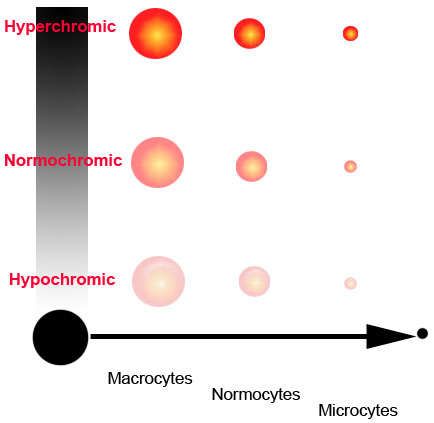|
Blood
Laboratory |
Blood cell indices
>
MCV and MCHC |
| |
Excessively low values of red
blood cell count, hematocrit, or hemoglobin may
be indicative of anemia (i.e. decreased oxygen carrying capacity of blood). There are many
different causes of anemia (e.g. loss of blood through hemorrhage, bone marrow disease,
iron deficiency, vitamin B12 deficiency, or folic acid deficiency, etc.) and some of those are
characterized by typically very small or very large red blood cells or reduced hemoglobin
concentration in each cell. |
| |
|
Diagnosis of the type of anemia may be assisted by relating
the measurements of red blood cell count, hematocrit and hemoglobin to derive the mean
corpuscular volume (MCV) and the mean corpuscular hemoglobin
concentration (MCHC). |
|
Erythrocytes that have a normal size or
volume (normal MCV) are called normocytic,
When the MCV is high, they are
called macrocytic.
When the MCV is low, they are termed microcytic.
Erythrocytes containing the normal amount of hemoglobin (normal MCHC) are called normochromic.
When the MCHC is abnormally low they are called hypochromic, and when the
MCHC is abnormally high, hyperchromic. |
 |
|
The terms above are used
together to describe different forms of anemia. For example, iron deficiency anemia is
described as microcytic and hypochromic, whereas vitamin B12 deficiency is macrocytic and
normochromic. |
|
Procedure |
| To calculate the MCV,
expressed in femtoliters (fl, or 10-15L), the following formula is used: |
|
 |
|
To calculate the MCHC, expressed as
grams of hemoglobin per 100 ml packed cells, the following formula is used: |
|
 |
The normal ranges for MCV and MCHC are as follows:
| |
MCV |
MCHC |
| Female: |
80-95 fl |
30-34 gHb/100ml |
| Male: |
80-95 fl |
30-34 gHb/100ml |
|
Sample problem: calculate the MCV and the
MCHC for a subject with a red blood cell count of 4x106 per cubic mm, a hematocrit of
40% and a hemoglobin concentration of 12 g/dl. Describe the subject's red cells: are they normocytic? normochromic? |
|
What is the answer? |
|
To continue
with the next section, White cell Count, click here |